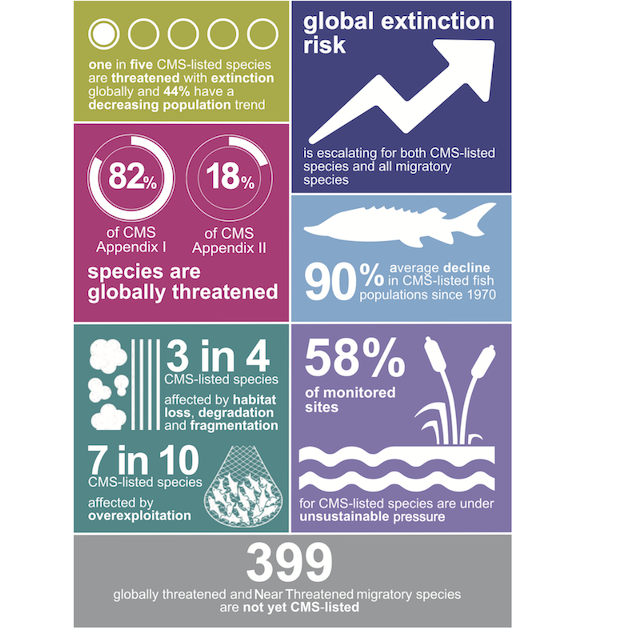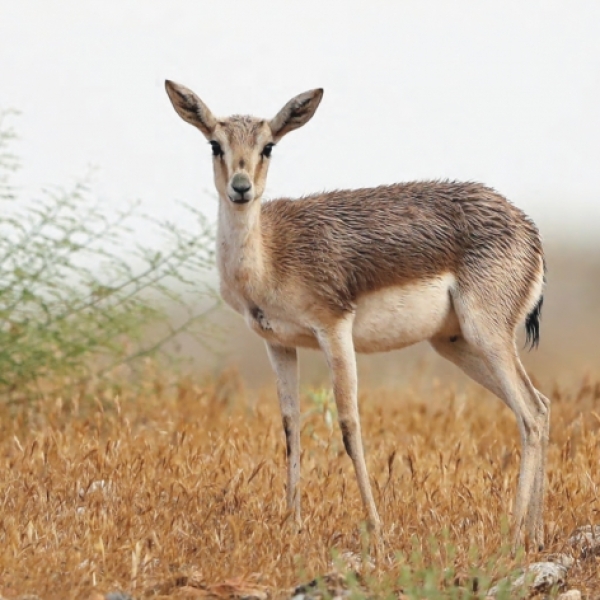DOMINICA, Feb 12 (IPS) — The United Nations inaugural assessment of the state of global migratory species states that 1 in 5 faces extinction and warns that the world cannot afford to miss this chance to act on recommendations to protect, connect, and restore habitats.A groundbreaking State of the World’s Migratory Species report is calling for accelerated global conservation measures to counter the threat of extinction faced by 1 in 5 of all migratory species.
The report was launched at the opening press conference of the 14th Conference of Parties to the UN Convention on the Conservation of Migratory Species of Wild Animals (CMS COP14) in Samarkand, Uzbekistan, on Feb. 12.
It is the first comprehensive assessment of migratory animals—species that travel to different parts of the world every year. They include ocean species like sharks and sea turtles, terrestrial animals such as elephants, as well as those undertaking airborne journeys like birds and butterflies. The report’s authors say migratory species’ remarkable journeys not only connect the world; they offer a unique angle to research and understand the magnitude of planetary changes.
The report has concluded that the conservation status of migratory species overall is deteriorating. Its results have been described as "startling" by the Executive Secretary of the Convention on the Conservation of Migratory Species of Wild Animals (CMS), Amy Fraenkel.
“Overexploitation emerges as the greatest threat for many migratory species, surpassing habitat loss and fragmentation,” she stated in the report. “This includes the taking of species from the wild through intentional removal, such as through hunting and fishing, as well as the incidental capture of non-target species. Bycatch of non-target species in fisheries is a leading cause of mortality of many CMS-listed marine species.”

Some of the troubling findings include population declines for almost half of CMS migratory species, extinction threats for almost all (97%) of CMS-listed fish, and a growing extinction risk for migratory species globally, including those not listed under the CMS.
“Migratory species are of ecological, economic, and cultural importance. Within ecosystems, they perform a variety of crucial functions, ranging from the large-scale transfer of nutrients between environments to the positive impacts of grazing animals on grassland biodiversity,” the report states.
It adds that these species’ habitats and movements are at risk, with half experiencing unsustainable levels of human-induced pressure.
“The urgency for action to protect and conserve these species becomes even greater when we consider the integral but undervalued role they play in maintaining the complex ecosystems that support a healthy planet—by, for example, transferring nutrients between environments, performing migratory grazing that supports the maintenance of carbon-storing habitats, and pollination and seed dispersal services,” said Inger Andersen, UN Under-Secretary-General and Executive Director, UN Environment Programme.
The present reality for migratory species and the cost of inaction or inadequate action are concerning, but the report is heavy on both hope and concrete recommendations for global action.
It contains a section dedicated to proposed policy actions. Among the most crucial are the need to address the unsustainable and illegal harvesting of migratory species at the national level, measures to reduce bycatch and other incidental captures, and the identification and recognition of all significant sites for migratory species.
The recommendations are to "protect, connect, and restore" habitats, tackle overexploitation, reduce the damaging impacts of environmental pollution, address the root causes and cross-cutting impacts of climate change, and ensure the CMS Appendices protect all migratory species in need of further conservation action. They also call for ‘follow-through’ on global commitments to ecosystem restoration.
“This includes those linked to the UN Decade on Ecosystem Restoration and Target 2 of the Kunming-Montreal Global Biodiversity Framework to ensure that at least 30% of degraded terrestrial, inland water, and coastal and marine ecosystems are under effective restoration by 2030. To support these efforts, develop and implement national restoration plans focused on restoring and maintaining important habitats for migratory species,” it states.
UNEP’s Inger Andersen says the report is an important milestone in the establishment of a roadmap for the conservation of migratory species.
“Given the precarious situation of many of these animals and their critical role for healthy and well-functioning ecosystems, we must not miss this chance to act—starting now by urgently implementing the recommendations set out in this report,” she stated.
For the CMS’ Amy Fraenkel, conservation of migratory species is a shared responsibility among the world’s nations.
“Migratory species are a shared natural treasure. This landmark report will help underpin much-needed policy actions to ensure that they continue to traverse the world’s skies, lands, oceans, lakes, and rivers.”
IPS UN Bureau Report






